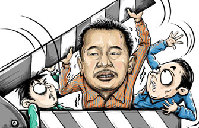The uncomfortable side of tradition
 |
 |
Do they have the right to non-conformity? Should they be encouraged to wear the robes of their own ethnicity.
And what if there are members of different ethnicities in the student body? Would they stand out in a sea of black gowns, and how would that make them feel?
What started as a subtle resistance against global compliance could inadvertently spark a scintilla of racial discomfort.
I'm sure nobody in the revive-Hanfu movement has any intention of discriminating against our compatriots of other ethnicities. But as a majority we sometimes forget that traditions of the Han people may not be accepted in all parts of China.
I hate to call it "racial insensitivity" as it does not imply any malice or bigotry, but it could develop into a form of racial ignorance.
The irony is that the discontinued use of the Hanfu was imposed upon the Han people when the Manchus started to rule China in 1644 and forced their own ethnic clothing and even hair styles on the Chinese majority.
When the Qing Dynasty was toppled in 1911, Western influences flooded in, leaving little room for reverting to the old way of Han clothing.
The elegant women's dress known as qipao, or cheongsam, which Chinese women sometimes wear as a national version of the evening gown, was an invention of the Manchus.
For those bent on restoring the former glory of Han culture, it is all the more urgent to have something that is quintessentially Han for grand occasions.
If you study Chinese history, you'll find that there were times of ethnic harmony and times of ethnic discord, which is nothing unusual.
Just as the Qing Dynasty forced its sartorial taste onto the Han people, the Han had also coerced some ethnic minorities to abandon their own formal wear or informal wear during draconian periods of rule.
Thankfully we are now in an age of tolerance and even appreciation of other cultures.
The constant changes in fashion probably have an impact on such attitudes as people are exposed to diverse styles.
In this atmosphere, respect for old traditions comes to be appreciated as vintage chic if not as strictly abiding by the bygone ways of life.
Sometimes I wonder whether many in the revival movement are in it for the chic, rather than the heritage.
All is well if people take care not to equate the Hanfu with the clothing of the entire country and not to belittle clothing choices of other ethnicities, or frown upon those Han people who do not want to join in.


















